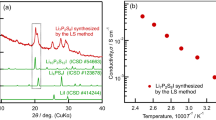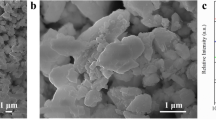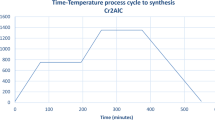Abstract
Commercial Ce0.8Gd0.2O2−δ nanopowders and alternative precursors synthesized by a freeze-drying method were used to obtain samples with and without Co addition as a sintering agent. Two percent Co-doped samples were sintered at 1150 °C and 1500 °C and undoped samples were sintered at 1500 °C or 1600 °C to obtain samples with relative densities in the range 92–94%. The total conductivity and the relative roles of bulk and grain boundary conductivity were studied by impedance spectroscopy. These results demonstrated that additions of Co play a very significant effect on the grain boundary behaviour, which is spoiled when the sintering temperature is excessive. Significant differences in grain boundary behaviour were also found between samples prepared from different precursor powders. The electronic conductivity of these materials was evaluated by an ion-blocking method and revealed that samples containing Co additions as a sintering additive possess somewhat lower n-type conductivity under identical conditions of temperature and oxygen partial pressure. The differences tend to vanish when these Co-doped samples are fired at high temperatures (1500 °C).










Similar content being viewed by others
Abbreviations
- CGO:
-
Ce0.8Gd0.2O1.9
- FD:
-
freeze-dried
- RH:
-
rhodia
References
Inaba H, Tagawa H (1996) Solid State Ionics 83:1
Yamamoto O (2000) Electrochim Acta 45:2423
Steele BCH (2000) Solid State Ionics 129:95
Kleinlogel C, Gauckler LJ (2000) Solid State Ionics 135:567
Fagg DP, Abrantes JCC, Pérez-Coll D, Núñez P, Kharton VV, Frade JR (2003) Electrochim Acta 48:1023
Lewis GS, Atkinson A, Steele BCH (2000) In: Bossel U (ed) Proceedings of the 4th Europe SOFC forum, vol 2. Oberrohrdorf, Switzerland, p 773
Zhang T, Hing P, Huang H, Kilner J (2002) J Eur Ceram Soc 22:27
Wang S, Kobayashi T, Dokiya M, Hashimoto T (2000) J Electrochem Soc 147:3606
Hebb M (1952) J Chem Phys 20:185
Navarro L, Marques F, Frade JR (1997) J Electrochem Soc 144:267
Lübke S, Wiemhöfer H-D (1999) Solid State Ionics 117:229
Riess I, Braunshtein D, Tannhauser DS (1981) J Am Ceram Soc 64:480
Adham KE, Hammou A (1983) Solid State Ionics 9–10:905
Christie GM, van Berkel FPF (1996) Solid Sate Ionics 83:17
Pérez-Coll D, Núñez P, Frade JR, Abrantes JCC (2003) Electrochim Acta 48:1551
Huang K, Feng M, Goodenough JB (1998) J Am Ceram Soc 81:357
Santos AP, Domingues RZ, Kleitz M (1998) J Eur Ceram Soc 18:1571
Abrantes JCC, Labrincha JA, Frade JR (2000) J Eur Ceram Soc 20:1603
Marques RMC, Marques FMB, Frade JR (1994) Solid State Ionics 73:15
Marques RMC, Marques FMB, Frade JR (1994) Solid State Ionics 73:27
Kim JH, Yoo HI (2001) Solid State Ionics 140:105
Acknowledgements
The authors acknowledge the financial support by the Spanish Research Program MCyT (MAT-2001-3334); by the Canary Islands Government (PI/2001/053); by FCT, Portugal, under contract POCTI/CTM/39381/2001; and by “Accion Integrada” HP01-82. We also thank M.E.C.D. for a F.P.U. grant (D.P.C) and “Convenio Cajacanarias-ULL” for another grant (D.M.L.).
Author information
Authors and Affiliations
Corresponding author
Additional information
Presented at the OSSEP Workshop “Ionic and Mixed Conductors: Methods and Processes”, Aveiro, Portugal, 10–12 April 2003
Rights and permissions
About this article
Cite this article
Pérez-Coll, D., Núñez, P., Marrero-López, D. et al. Effects of sintering additives on the mixed transport properties of ceria-based materials under reducing conditions. J Solid State Electrochem 8, 644–649 (2004). https://doi.org/10.1007/s10008-004-0505-1
Received:
Accepted:
Published:
Issue Date:
DOI: https://doi.org/10.1007/s10008-004-0505-1




